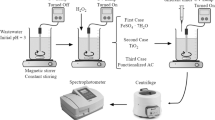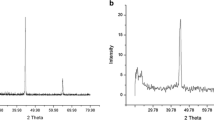Abstract
The textile industries’ production of effluents with a high content of organic matter and coloration is notorious, particularly as regards their effect on the aquatic environment. This occurs in the presence of dyes that inhibit light penetration, thus affecting the biodegradability of the medium. This study evaluates the advanced oxidative processes (AOP) for use in the degradation of the reactive red 195 and direct black 22 textile dyes using bench reactors. The photo-Fenton/sunlight process was efficient, achieving a degradation of over 99% for the chromophore groups after 150 min when utilizing [H2O2] = 60 mg L−1, [Fe] = 1 mg L−1, and a pH of between 3 and 4. The kinetic model into which the experimental data best fitted was the non-linear model which employs wavelength monitoring. The COD study indicated an organic matter conversion rate of 94.96%, with a good kinetic adjustment (R2= 0.9927. A mathematical model was proposed to estimate the degradation (%) according to the variables [H2O2], [Fe], pH, and λ. In addition, the present study evaluated the toxicity of the solution, both before and after the treatment, and was verified that the treated solution was toxic by using a concentration of 10% of Lactuca sativa and Syzygium aromaticum seeds. The toxicity analysis using microbiological techniques showed that, after the treatment, the percentage of inhibition was reduced considerably, dropping to 46.0% for the sample without dilution and inhibiting only 33.4% for SPT1%.





Similar content being viewed by others
References
APHA. (2012). Standard methods for the examination of water and wastewater (22nd ed.). Washington, DC: American Public Health Association (APHA), American Water Works Association, and Water and Environment Federation.
Araújo, K. S., Antonelli, R., Gaydeczka, B., Granato, A. C., & Malpass, G. R. P. (2016). Processos oxidativos avançados: uma revisão de fundamentos e aplicações no tratamento de águas residuais urbanas e efluentes industriais. Ambiente e Água, 11, 387–401.
Baeissa, E. S. (2016). Photocatalytic degradation of malachite green dye using Au/NaNbO3 nanoparticles. Journal of Alloys and Compounds, 672, 564–570. https://doi.org/10.1016/j.jallcom.2016.02.024.
Bonakdarpour, B., Vyrides, I., & Stuckey, D. C. (2011). Comparison of the performance of one stage and two stage sequential anaerobic–aerobic biological processes for the treatment of reactive-azo-dye-containing synthetic wastewaters. International Biodeterioration & Biodegradation, 65, 591–599. https://doi.org/10.1016/j.ibiod.2011.03.002.
Brito, N. N. D., & Silva, V. B. M. (2012). Processos oxidativos avançados e sua aplicação ambiental. Revista Eletrônica de Engenharia Civil, 1, 36–47. https://doi.org/10.5216/reec.v3i1.17000.
Cai, M., Su, J., Zhu, Y., Wei, X., Jin, M., Zhang, H., Dong, C., & Wei, Z. (2016). Decolorization of azo dyes Orange G using hydrodynamic cavitation coupled with heterogeneous Fenton process. Ultrasonics Sonochemistry, 28, 302–310. https://doi.org/10.1016/j.ultsonch.2015.08.001.
Chan, K. H., & Chu, W. (2003). Modeling the reaction kinetics of Fenton’s process on the removal of atrazine. Chemosphere, 51, 305–311. https://doi.org/10.1016/S0045-6535(02)00812-3.
Chen, X., Zhao, Y., Moutinho, J., Shao, J., Zydney, A. L., & He, Y. (2015). Recovery of small dye molecules from aqueous solutions using charged ultrafiltration membranes. Journal of Hazardous Materials, 284, 58–64. https://doi.org/10.1016/j.jhazmat.2014.10.031.
Dewil, R., Mantzavinos, D., Poulios, I., & Rodrigo, M. A. (2017). New perspectives for advanced oxidation processes. Journal of Environmental Management, 195(1), 93–99.
Elaissaoui, I., Akrout, H., Grassini, S., Fulginiti, D. & Bousselmi, L. (2019). Effect of coating method on the structure and properties of a novel PbO2 anode for electrochemical oxidation of Amaranth dye. Chemosphere, 217, 26-34. https://doi.org/10.1016/j.chemosphere.2018.10.161.
Elhalil, H., Tounsadi, R. E., Mahjoubi, F. Z., Farnane, M., Sadiq, M., Abdennouri, M., Qourzal, S., & Barka, N. (2016). Factorial experimental design for the optimization of catalytic degradation of malachite green dye in aqueous solution by Fenton process. Water Resources and Industry, 15, 41–48. https://doi.org/10.1016/j.wri.2016.07.002.
Ertugay, N., & Acar, F. N. (2017). Removal of COD and color from Direct Blue 71 azo dye wastewater by Fenton’s oxidation: kinetic study. Arabian Journal of Chemistry, (10), 1158–1163. https://doi.org/10.1016/j.arabjc.2013.02.009.
Fernandes, N. C., Brito, L. B., Costa, G. G., Taveira, S. F., Cunha–Filho, M. S. S., Oliveira, G. A. R. & Marreto, R. N. (2018). Removal of azo dye using Fenton and Fenton-like processes: Evaluation of process factors by Box–Behnken design and ecotoxicity tests. Chemico-biological interactions, 291, 47-54. https://doi.org/10.1016/j.cbi.2018.06.003.
Instituto Nacional de Metrologia, Normalização e Qualidade Industrial (INMETRO). (2011). DOQ-CGCRE-008. Orientações sobre Validação de Métodos Analíticos. Rev, 04, 20.
Lau, Y. Y., Wong, Y. S., Teng, T. T., Morad, N., Rafatullah, M., & Ong, S. A. (2014). Coagulation-flocculation of azo dye Acid Orange 7 with green refined laterite soil. Chemical Engineering Journal, 246, 383–390. https://doi.org/10.1016/j.cej.2014.02.100.
Leite, L. S., Maselli, B. S., Umbuzeiro, G. A., & Nogueira, R. F. P. (2016). Monitoring ecotoxicity of disperse red 1 dye during photo-Fenton degradation. Chemosphere, 148, 511–517.
Lima, D. R. S., Almeida, I. L. A., & Paula, V. I. (2016). Degradação do corante azul reativo 5G pelo processo oxidativo avançado UV/H2O2. E-xacta, 9, 101–109. https://doi.org/10.18674/exacta.v9i2.1915.
Martins, J. E. C. A., Neto, E. F. A., Lima, A. C. A., Ribeiro, J. P., Maia, F. E. F., & Nascimento, R. F. (2018). Delineamento Box-Behnken para remoção de DQO de efluente têxtil utilizando eletrocoagulação com corrente contínua pulsada. Engenharia Sanitária e Ambiental, 22(6), 1–10.
Mitre, T. K., Leão, M. M. D., & Alvarenga, M. C. N. (2012). Tratamento de águas contaminadas por diesel/biodiesel utilizando processo Fenton. Engenharia Sanitária e Ambiental, 17, 129–136.
Napoleão, D. C. (2015) Avaliação e tratamento de fármacos oriundos de diferentes estações de tratamento de efluentes empregando processos oxidativos avançado. Tese de doutorado. Universidade Federal de Pernambuco, Recife, UFPE.
Nascimento, G. E., Napoleão, D. C., Aguiar Silva, P. K., Santana, R. M. R., Bastos, A. M. R., Zaidan, L. E. M. C., & Duarte, M. M. M. B. (2018). Photo-assisted degradation, toxicological assessment, and modeling using artificial neural networks of reactive gray BF-2R dye. Water, Air, & Soil Pollution, 229(12), 379.
Oller, I., Malato, S., & Sánchez-Pérez, J. A. (2011). Combination of advanced oxidationprocesses and biological treatments for wastewater decontamination - a review. Science of the Total Environment, 409, 4141–4166. https://doi.org/10.1016/j.scitotenv.2010.08.061.
Palácio, S. M., Nogueira, D. A., Manenti, D. R., Módenes, N. A., Espinoza-Quiñones, F. R., & Borba, F. H. (2012). Estudo da toxicidade de efluente têxtil tratado por foto-Fenton artificial utilizando as espécies Lactuca Sativa e Artemia Salina. Engevista, 14, 127–134.
Paulino, T. R. S., Araújo, R. S., & Salgado, B. C. B. (2015). Estudo de oxidação avançada de corantes básicos via reação Fenton (Fe2+/H2O2 ). Engenharia Sanitaria e Ambiental, 20, 347–352. https://doi.org/10.1590/S1413-41522015020000111627.
Peixoto, F., Marinho, G., & Rodrigues, K. (2013). Corantes têxteis: uma revisão. Holos, 5, 98–106.
Pereira, G. F., El-Ghenymy, A., Thiam, A., Carlesi, C., Eguiluz, K. I. B., Salazar-Banda, G. R., & Brillas, E. (2016). Effective removal of Orange-G azo dye from water by electro-Fenton and photoelectro-Fenton processes using a boron-doped diamond anode. Separation and Purification Technology, 160, 145–151. https://doi.org/10.1016/j.seppur.2016.01.029.
Rajabi, M., Mirza, B., Mahanpoor, K., Mirjalili, M., Najafi, F., Moradi, O., Sadegh, H., Shahryari-ghoshekandi, R., Asif, M., Tyagi, I., Agarwal, S., & Gupta, V. K. (2016). Adsorption of malachite green from aqueous solution by carboxylate group functionalized multi-walled carbon nanotubes: determination of equilibrium and kinetics parameters. Journal of Industrial and Engineering Chemistry, 34, 130–138. https://doi.org/10.1016/j.jiec.2015.11.001.
Rajkumar, D., & Palanivelu, K. (2004). Electrochemical treatment of industrial wastewater. Journal of Hazardous Materials, 133, 123–129. https://doi.org/10.1016/j.jhazmat.2004.05.039.
Rodrigues, C. O., & Külzer, B. N. (2016). Geração e processos físico-químicos de tratamento de efluentes líquidos contendo pigmentos. Holos Environment, 16(1), 58–69.
Santana, R. M. R., Nascimento, G. E., Napoleão, D. C., & Duarte, M. M. M. B. (2017). Degradation and kinetic study of reactive blue BF-5G and Remazol red RB 133% dyes using Fenton and photo-Fenton process. Reget., 31, 104–118. https://doi.org/10.5902/22361170.
Santana, R. M. R., Nascimento, G. E., Silva, P. K. A., Lucena, A. L. A., Procópio, T. F., Napoleão, T. H., Duarte, M. M. B., & Napoelão, D. C. (2018). Kinetic and ecotoxicological evaluation of the direct orange 26 dye degradation by Fenton and solar photo-Fenton processes. Revista Eletrônica em Gestão, Educação e Tecnologia Ambiental, 22(5), 1–20.
Silva, L. R. C., Silva, T. L., Araújo, F. P., Silva Filho, E. C., & Osajima, J. A. (2017). Uso de fotólise direta e H2O2/UV em solução aquosa contendo o corante violeta cristal. Holos Environment, 17, 138–148.
Souza, S. J. O., Lobo, T. M., Sabino, A. L. O., Oliveira, S. B., & Costa, O. S. (2010). Decomposição dos antirretrovirais lamivudina e zidovudina pelo processo foto-Fenton assistido no efluente de indústria farmoquímica. Revista Processos Químicos, 4, 5967.
Su, C. C., Pukdee-Asa, M., Ratanatamskul, C., & Lu, M. C. (2011). Effect of operating parameters on decolorization and COD removal of three reactive dyes by Fenton’s reagent using fluidized-bed reactor. Desalination, 278, 211–218. https://doi.org/10.1016/j.desal.2011.05.022.
Tiburtius, E. R. L., Peralta-Zamora, P., & Emmel, A. (2009). Degradação de benzeno, tolueno e xilenos em águas contaminadas por gasolina, utilizando-se processos foto-Fenton. Química Nova, 32(8), 2058–2063. https://doi.org/10.1590/S0100-40422009000800014.
Young, B. J., Riera, N. I., Beily, M. E., Bres, P. A., Crespo, D. C., & Ronco, A. E. (2012). Toxicity of the effluent from an anaerobic bioreactor treating cereal residues on Lactuca sativa. Ecotoxicology and Environmental Safety, 76, 182–186. https://doi.org/10.1016/j.ecoenv.2011.09.019.
Zaidan, L. E. M. C., Pinheiro, R. B., Santana, R. M. R., Charamba, L. V. C., Napoleão, D. C., & Silva, V. L. (2017). Evaluation of efficiency of advanced oxidative process in degradation of 2-4 dichlorophenol employing UV-C radiation reator. Reget, 21, 147–157. https://doi.org/10.5902/22361170.
Zanoni, M. V. B., & Yamanaka, H. (2016). Corantes: caracterização química, toxicológica, métodos de detecção e tratamento (1st ed.). São Paulo: Cultura Acadêmica.
Acknowledgments
The authors thank Núcleo de Química Analítica Avançada de Pernambuco da Fundação de Amparo a Ciência e Tecnologia de Pernambuco (NUQAAPE/FACEPE), Fundação de Apoio ao Desenvolvimento (FADE/UFPE), and Laboratório de Bioquímica de Proteínas da Universidade Federal de Pernambuco.
Author information
Authors and Affiliations
Corresponding author
Ethics declarations
Conflict of Interest
The authors declare that they have no conflict of interest.
Additional information
Publisher’s Note
Springer Nature remains neutral with regard to jurisdictional claims in published maps and institutional affiliations.
Rights and permissions
About this article
Cite this article
Santana, R.M.d., Charamba, L.C.V., do Nascimento, G.E. et al. Degradation of Textile Dyes Employing Advanced Oxidative Processes: Kinetic, Equilibrium Modeling, and Toxicity Study of Seeds and Bacteria. Water Air Soil Pollut 230, 136 (2019). https://doi.org/10.1007/s11270-019-4178-x
Received:
Accepted:
Published:
DOI: https://doi.org/10.1007/s11270-019-4178-x




